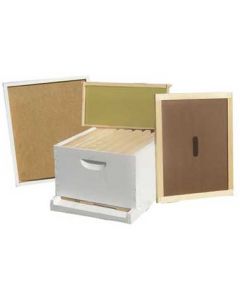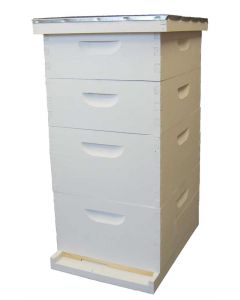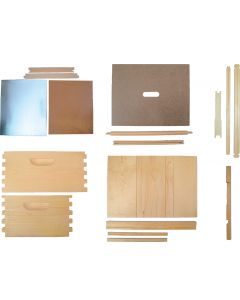Complete Hives (10-Frame)
Beginner Beekeeping Tips
If you’re new to beekeeping, purchasing a complete hive is a great investment. You won’t have to worry about assembling a hive by yourself.
Before purchasing a complete hive, we recommend familiarizing yourself with hive parts and the difference between wood and plastic hive parts so you can make the best option for yourself.
Hive Parts
In a Langstroth hive, there are seven main components that a beekeeper should familiarize themselves with. From bottom up, these are: a hive stand, bottom board, hive body, queen excluder, honey super, inner cover, and a hive cover.
Hive Stand
A hive stand elevates the hive off of the ground to keep the bottom board dry and insulate the hive.
Bottom Board
A bottom board is the floor of the beehive. It provides an entrance and exit for bees to enter and leave the hive. Screened bottom boards have become more popular in the last decade because it provides more ventilation, improves moisture control, and keeps varroa mite numbers down. The Dadant Screen IPM Board has a removable monitoring screen so you can check the varroa levels in a hive.
Hive Body
The hive body is where bees reside, and can house 50,000-60,000 bees at a time. In the hive body, worker bees store honey and pollen and the queen lays her eggs.
To prevent swarming and keep bees alive during long, cold winters, some beekeepers stack two hive bodies so worker bees can store more food.
The hive body also holds frames where bees build comb. Depending on the hive body you choose, it may hold up to eight or 10 frames.
Queen Excluder
A queen excluder prevents the larger queen from leaving the hive body, but has just enough space for worker bees to pass through. The queen stays in one place to lay eggs and raise brood, while the worker bees fill frames in the upper sections with honey. A queen excluder is not necessary if you have two hive bodies.
Honey Supers
Honey supers are shallow boxes placed above the hive body. Beekeepers extract honey from honey super frames instead of the hive body.
Inner Cover
The inner cover provides the perfect amount of working space and ventilation bees need to stay comfortable. Some beekeepers do not use inner covers depending on the outer cover they use.
Outer Cover
The outer cover functions as the beehive “roof” and provides additional protection, ventilation and insulation. Most beekeepers use a telescoping outer cover along with an inner cover. Commercial beekeepers often use migratory outer covers, which do not require an inner cover.
Hive Materials
Hives are traditionally made from wood, but Plasticell has become more popular in recent years due to its insulating and cooling properties. Keep in mind that choosing the material for the hive body depends on your own preferences.
The choice between wood and plastic frames is ultimately more important when choosing the frame foundation you’ll use.
Plastic Frames
Plastic beehive frames are often delivered with foundation already, and they may last longer than wood frames. These frames must be coated with wax for bees to accept it. It is also impossible for pests to burrow through them.
However, plastic beehive frames cannot be used with wax foundation, and they cannot be foundationless either. Once these frames break, they cannot be repaired, and can only be thrown away or recycled.
Wood Frames
Wood is a natural material, and bees love it, especially because a colony’s natural habitat is in a hollow tree.
Wood frames can be used with both wax and plastic foundation, which means that you can experiment with a foundation you like. In contrast to plastic frames, these can easily be repaired, providing you have more wood on hand.
However, wood frames are much heavier than plastic, and may make your hive body too heavy to lift. Wood frames often come unassembled as well, which may be too daunting for a new beekeeper.
To use these frames with wax foundation, you must wire these frames to add strength to comb. Fortunately, Dadant offers crimp wired foundation ready to go out of the package!
What should a beginner use?
If you’re just starting out, purchasing a complete kit will take the weight off of your shoulders. From there, you can experiment with various methods, and test out what works for you. We recommend starting out with a plastic frame and foundation before trying wooden frames and wax foundations.









![[13" Version] 10-Frame Moisture Box Handle Replacement Assembly](https://www.dadant.com/catalog/media/catalog/product/cache/61da60bd5ee8ab16f86f3b06568ed40e/m/6/m60060-01-handlereplacementassembly-10-frame-for-moisturehive-web.jpg)

![[16¼" Version] 10-Frame Moisture Box Handle Replacement Assembly](https://www.dadant.com/catalog/media/catalog/product/cache/61da60bd5ee8ab16f86f3b06568ed40e/m/6/m60060-01r-moisture-box-handle-3_web.jpg)




